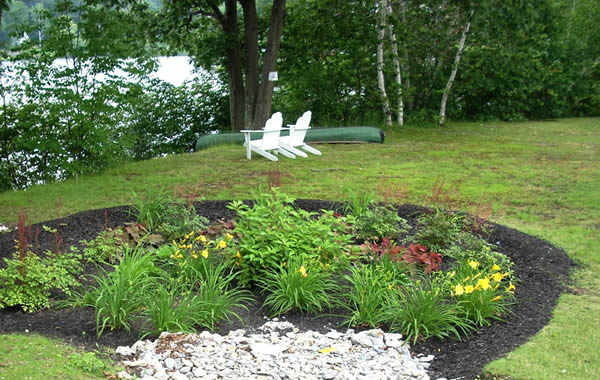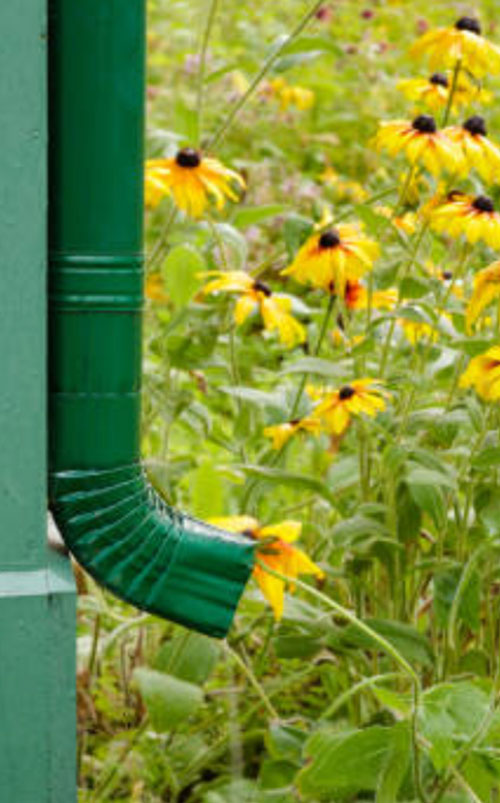Gardening is a way of showing that you believe in tomorrow.
Rain Gardens


Rain Gardens are one of the newest garden types around. Not only are they beautiful, they filter rainwater, help reduce runoff and attract wildlife like birds and butterflies!! They are easy to build and maintain, too.
A rain garden collects rain from a house’s downspout so the water doesn’t wash off into the street with pollution from the house and lawn. The rain is absorbed by the deep rooted plants in the shallow bowl-shaped garden, preventing runoff from getting into streams and rivers.
Native plants are traditionally the way to go, however, rain gardens don’t have to look out of place in your front yard.
Northern Sunset Perennials suitable for the rain garden will have the rain garden icon on the label. We’ve listed rain garden plants for native (or casual) and formal applications separately for you.
What is a rain garden?
A rain garden is a shallow depression, usually 10”-12” deep, made specifically to collect and filter rain water. Water doesn’t stand in a rain garden, but trickles through the soil. Oil, chemicals and other pollutants are filtered and stopped by soil particles or taken up by the roots. Rain gardens are great habitat for birds, butterflies, and beneficial insects. They are not a breeding ground for mosquitoes because the water doesn’t stand long.
Where do I locate my rain garden?
- Typically your rain garden should be placed where water drains from the downspout.
- Choose a spot on a gentle slope (slanting away from the house), at least 8 feet from the house.
- Your rain garden can be incorporated into a foundation planting as long as the above applies.
- The further your rain garden is away from the house, the larger it should be, as it will be catching water from a larger area.
- Avoid areas where water already pools. Rain gardens need to drain. Use bog garden plants instead.
Formal Rain Garden Plants
ACHILLEA millefolium Cultivars
AGASTACHE foeniculum Cultivars
ALCHEMILLA species
ARUNCUS dioicus Cultivars
ASCLEPIAS incarnata Cultivars
ASTER lateriflorus Lady in Black
ASTER novae-angliae Cultivars
ASTER novae-belgii Cultivars
ASTILBE chinensis Cultivars
BOLTONIA asteroides Cultivars
COREOPSIS verticillata Cultivars
ECHINACEA purpurea Cultivars and Hybrids
EUPATORIUM maculatum Cultivars
EUPATORIUM purpureum Cultivars
GERANIUM maculatum Cultivars
HELENIUM autumnale Cultivars & Hybrids
HELIOPSIS helianthoides Cultivars & Hybrids
HEMEROCALLIS Hybrids
HEUCHERA americana Cultivars
HEUCHERA villosa Cultivars
HOSTA species and Hybrids
IRIS siberica Cultivars
LOBELIA cardinalis Cultivars & Hybrids
MONARDA didyma Cultivars and Hybrids
PENSTEMON digitalis Cultivars and Hybrids
PHLOX divaricata Cultivars
PHYSOSTEGIA virginiana Cultivars
RODGERSIA species
RUDBECKIA fulgida Cultivars
RUDBECKIA hirta Cultivars
RUDBECKIA subtomentosa Cultivars
RUDBECKIA triloba Cultivars
SOLIDAGO Cultivars and Hybrids
VERONICASTRUM virginicum Cultivars
GRASSES
ANDROPOGON gerardii Cultivars
CALAMAGROSTIS acutiflora Cultivars
CALAMAGROSTIS arundinacea Brachytricha
CAREX dolichostachya Gold Fountians
CAREX elata Aurea
CAREX flacca
CAREX morrowii Cultivars
CAREX muskingumensis Cultivars
CAREX oshimensis Evergold
JUNCUS filiformis Spiralis
PANICUM virgatum Cultivars
SORGHASTRUM nutans Cultivars
Native Rain Garden Plants
ACORUS calamus
(Common Sweet Flag)
AGASTACHE foeniculum
(Blue Giant Hyssop)
ALLIUM cernuum
(Nodding Pink Onion)
ARISAEMA triphyllum
(Jack-in-the-Pulpit)
ARUNCUS dioicus
(Goatsbeard)
ASCLEPIAS incarnata
(Swamp Milkweed)
ASTER novae-angliae
(New England Aster)
BAPTISIA species
(False Indigo)
CALTHA palustris
(Marsh Marigold)
COREOPSIS lanceolata
(Lanceleaf Tickseed)
DODECATHEON meadia
(Shooting-star)
ECHINACEA purpurea
(Purple Coneflower)
EUPATORIUM maculatum
(Joe-Pye Weed)
EUPATORIUM perfoliatum (Common Boneset)
EUPATORIUM purpureum
(Sweet Joe-Pye Weed)
GERANIUM maculatum
(Wild Geranium)
HELENIUM autumnale
(Autumn Sneezeweed)
HELIOPSIS helianthoides
(False Sunflower)
HEUCHERA richardsonii (Prairie Alumroot)
HEUCHERA villosa
macrorrhiza
(Downy Allumroot)
IRIS versicolor
(Larger Blue Flag Iris)
IRIS virginica shrevei (Virginia Flag Iris)
LIATRIS pycnostachya (Prairie Blazing Star)
LIATRIS spicata
(Spike Blazing Star)
LILIUM michiganense (Turk’s Cap Lily)
LILIUM superbum
(Turk’s Cap Lily)
LOBELIA cardinalis (Cardinal Flower)
LOBELIA siphilitica
(Blue Cardinal Flower)
MERTENSIA virginica (Virginia Bluebells)
MONARDA fistulosa
(Wild Bergamot)
PARTHENIUM integrifolium
(American Feverfew)
PENSTEMON digitalis (White Penstemon)
PHLOX divaricata
(Woodland Phlox)
Phlox divaricata laphamii (Wild Phlox)
PHLOX glaberrima interior
(Smooth Phlox)
PHYSOSTEGIA virginiana (Obedient Plant)
RATIBIDA pinnata
(Yellow Coneflower)
RUDBECKIA fulgida speciosa
(Showy Coneflower)
RUDBECKIA hirta
(Black-eyed Susan)
RUDBECKIA maxima (Great Coneflower)
RUDBECKIA subtomentosa (Sweet Coneflower)
RUDBECKIA triloba
(Branched Coneflower)
SENNA hebecarpa
(Wild Senna)
SILPHIUM perfoliatum (Cup Plant)
SILPHIUM terebinthinaceum
(Prairie Dock)
SOLIDAGO species
(Goldenrod)
VERBENA hastata
(Blue Vervain)
VERNONIA fasciculata (Ironweed)
VERONICASTRUM virginicum (Culver’s Root)
Ferns
ONOCLEA sensibilis
(Sensitive Fern)
OSMUNDA claytoniana (Interrupted Fern)
OSMUNDA cinnamomea
(Cinnamon Fern)
Grasses
ANDROPOGON gerardii
(Big Bluestem)
CAREX bebbii
(Bebb’s Sedge)
CAREX bicknellii
(Bicknell’s Sedge)
CAREX blanda
(Common Woodland Sedge)
CAREX grayi
(Morning Star Sedge)
CAREX hystericina
(Porcupine Sedge)
CAREX lurida
(Lurid Sedge)
CAREX muskingumensis
(Palm Sedge)
CAREX pensylvanica (Pennsylvania Sedge)
CAREX vulpinoidea
(Fox Sedge)
ELYMUS Canadensis
(Canada Wild Rye)
JUNCUS effuses
(Soft Rush)
JUNCUS torreyi
(Torrey’s Rush)
PANICUM virgatum
(Switch Grass)
SORGASTRUM nutans
(Indian Grass)
SPARTINA pectinata
(Prairie Cordgrass)
More Information on Rain Gardens
There is lots of information about rain gardens on the web. Here are a few of our favorites, along with a list of perennials suitable for rain gardens both formal and informal.
Rain Garden Designs from Maplewood, MN
Rain garden plans
Wisconsin Department of Natural Resources
A whole site dedicated to learning about and creating rain gardens, including how to get kids involved!
Rain gardens of West Michigan
Learning about and creating them
